Das Hinzufügen eines Favicons zu Ihrem WordPress-Blog ist ein einfacher, aber wirkungsvoller Schritt für das Branding Ihrer Website. Ein Favicon ist ein kleines Bild, das neben dem Titel Ihrer Website in Browser-Tabs, Lesezeichen und mehr angezeigt wird.
Das Problem ist, dass viele neue Blogger dieses Detail übersehen oder denken, dass es zu technisch ist, um damit umzugehen. Andererseits kann das Fehlen eines Favicons es Ihrem Publikum erschweren, Ihre Website auf den ersten Blick zu erkennen, was zu weniger Rückbesuchen oder Engagement führen kann.
Ein Grund, warum wir bei WPBeginner ein Favicon verwenden, ist, dass unsere Leser unsere Seite schnell unter ihren geöffneten Tabs und Lesezeichen erkennen können. Dieses Detail trägt auch dazu bei, unsere Marke zu stärken und eine professionellere Online-Präsenz zu gewährleisten.
Glücklicherweise muss das Hinzufügen eines Favicons zu Ihrem WordPress-Blog nicht kompliziert sein. In diesem Leitfaden zeigen wir Ihnen, wie Sie Ihr Website-Symbol ganz einfach einrichten können, damit Ihr Blog sich von anderen abhebt.
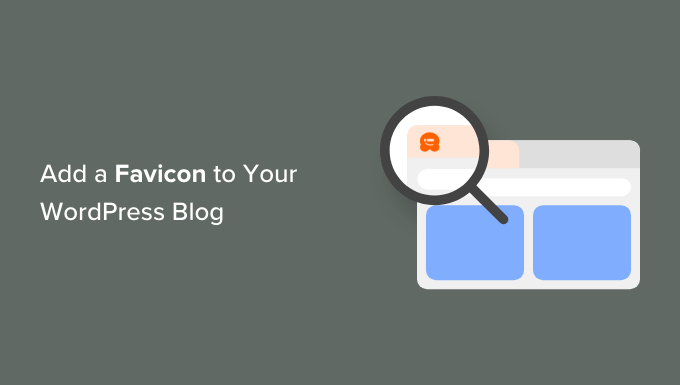
Warum sollten Sie ein Favicon zu Ihrem WordPress-Blog hinzufügen?
Ein Favicon ist für Ihren WordPress-Blog unverzichtbar, da es den Nutzern hilft, Ihre Website schnell zu identifizieren und Ihre Markenidentität zu stärken. Anhand dieses kleinen Symbols können Website-Besucher Ihren Blog leicht erkennen.
So sieht ein Favicon in einem Webbrowser aus:

Ein weiterer Zweck eines WordPress-Favicons ist die Verbesserung der Benutzerfreundlichkeit. Wenn mehrere Tabs geöffnet sind, können die Nutzer anhand der Favicons erkennen, auf welcher Website sie sich befinden, und zu der gewünschten Website wechseln.
Wenn Nutzer auf ihren mobilen Geräten ein Verknüpfungssymbol oder ein Lesezeichen zu Ihrem Blog hinzufügen, wird das Favicon als App-Symbol auf ihrem Startbildschirm angezeigt. So können sie mit einem einfachen Fingertipp auf Ihre Website zugreifen.
Favicons können auch bei der WordPress-Suchmaschinenoptimierung (SEO) helfen. Wenn Sie auf die Seiten in den Suchergebnissen achten, wird das Favicon der Website in der Regel vor dem Metatitel der Seite angezeigt. Dies kann Ihre Website seriös und vertrauenswürdig erscheinen lassen.
Wie Sie ein Favicon für Ihren WordPress-Blog erstellen
Als Erstes wollen wir lernen, wie man ein gutes Favicon für sein Blog erstellt.
Die ideale Größe eines WordPress-Favicons ist ein quadratisches Bild mit einer Breite und Höhe von bis zu 512 Pixeln. Das Favicon-Bildformat kann ICO, JPEG, PNG oder GIF sein.
SVG ist auch ein gängiges Format für Favicons, wird aber von WordPress standardmäßig nicht akzeptiert. Sie können WordPress jedoch so konfigurieren, dass Sie SVG-Dateien hinzufügen können.
Wenn Sie einen Unternehmensblog betreiben, können Sie Ihr Markenlogo als Favicon-Symbol verwenden. Wenn Sie noch kein Logo haben, können Sie in unserem Leitfaden für Anfänger nachlesen, wie Sie ein Logo für Ihre Website erstellen.
Wenn Sie ein fertiges Logo haben, aber den Hintergrund transparent machen wollen, können Sie Photoshop oder ein kostenloses Bildbearbeitungsprogramm mit automatischer Hintergrundentfernung verwenden. Achten Sie nur darauf, dass das Dateiformat PNG ist, damit die Transparenz des Favicons erhalten bleibt.
Eine weitere Möglichkeit ist ein kostenloser Favicon-Generator wie Favicon.io. Mit diesem Tool können Sie ein Favicon von Grund auf anpassen und die Dateien im PNG- und ICO-Format herunterladen.
In diesem Sinne erfahren Sie hier, wie Sie Ihrem WordPress-Blog ganz einfach ein Favicon hinzufügen können. Wir werden 4 Methoden behandeln, und Sie können auf die Links unten klicken, um zu der Methode zu springen, die Sie verwenden möchten:
Sind Sie bereit? Dann fangen wir an.
Methode 1: Hinzufügen eines Favicons mit dem WordPress Customizer
Dies ist die einfachste Methode, ein Favicon in WordPress zu ändern. Alles, was Sie tun müssen, ist Ihr Favicon-Bild in den WordPress Customizer hochzuladen, und der Rest wird für Sie erledigt.
Der erste Schritt ist der Zugriff auf den WordPress Customizer. Wenn Sie ein klassisches Theme verwenden, können Sie dazu zu Erscheinungsbild ” Anpassen navigieren.
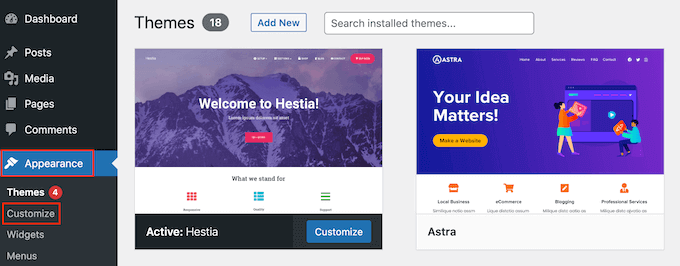
Wenn Sie ein Block-Theme verwenden und den Customizer nicht finden können, dann lesen Sie unsere Anleitung, wie Sie den fehlenden Theme Customizer im WordPress-Admin beheben.
Als Nächstes klicken wir auf die Registerkarte “Site Identity” in der linken Seitenleiste.
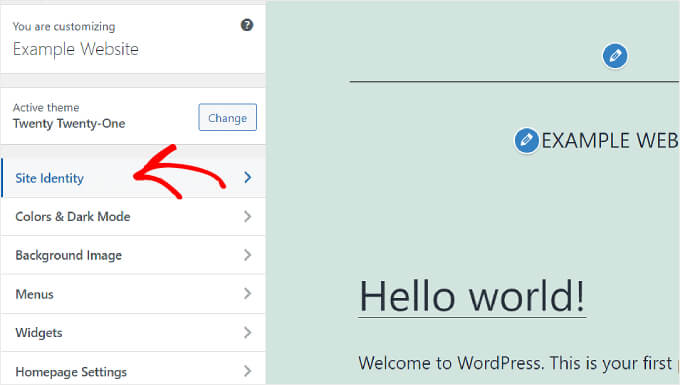
Hier sehen Sie Optionen, um Ihr ‘Site-Logo’, ‘Site-Titel’, ‘Tagline’ und ‘Site-Symbol’ anzupassen.
Wenn Sie das Favicon einer Website hinzufügen möchten, müssen Sie zum Abschnitt “Website-Symbol” scrollen und auf “Website-Symbol auswählen” klicken.
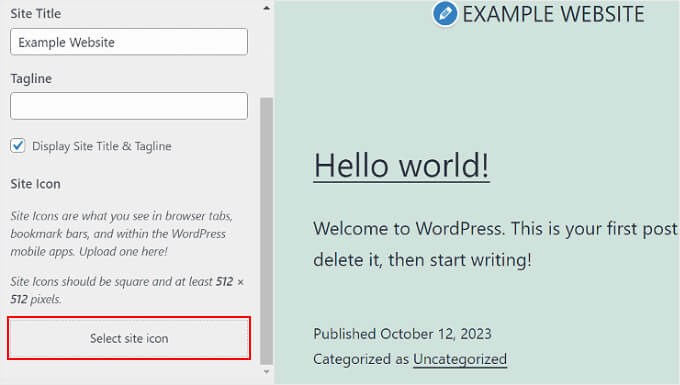
Die WordPress-Mediathek wird nun angezeigt. Sie können entweder ein vorhandenes Bild auswählen oder ein neues benutzerdefiniertes Favicon von Ihrem Computer hochladen.
In diesem Beispiel werden wir das Logo von WPBeginner als WordPress-Site-Icon verwenden.
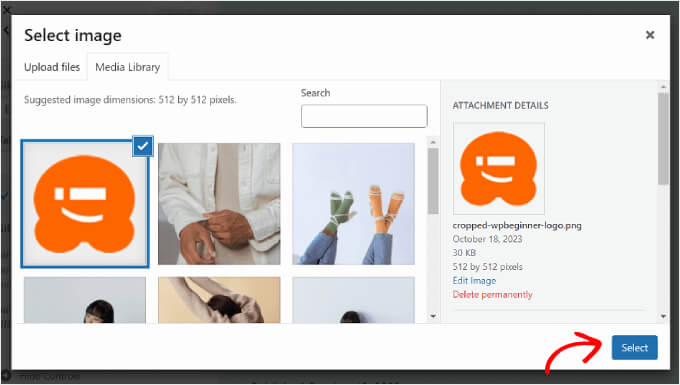
Nachdem Sie ein Bild ausgewählt haben, klicken Sie auf die Schaltfläche “Auswählen” in der unteren rechten Ecke des Fensters.
Wenn das Favicon größer als die empfohlene Größe ist, können Sie es in WordPress zuschneiden. Wenn es genau der empfohlenen Größe entspricht, können Sie es einfach so lassen, wie es ist.
Wenn das Bild gut aussieht, klicken Sie einfach auf “Bild zuschneiden”.
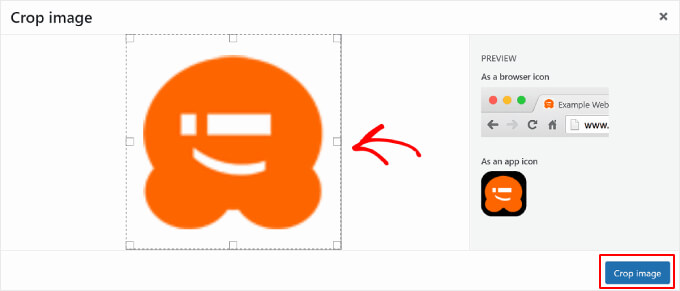
Danach werden Sie zum WordPress Customizer zurückgeführt. Hier können Sie die Einrichtung Ihres Favicons abschließen, indem Sie auf die Schaltfläche “Veröffentlichen” in der linken Seitenleiste klicken.
Das war’s! Jetzt, wo Sie Ihr Favicon hochgeladen haben, können Sie Ihre WordPress-Website besuchen, um zu sehen, ob das Bild bereits live ist.
Methode 2: Hinzufügen eines Favicons mit dem WordPress Full Site Editor
Wenn Sie ein Block-Theme verwenden und Ihr Markenlogo sowohl als Teil der Kopfzeile Ihrer Website als auch als Website-Symbol einfügen möchten, dann ist diese Methode für Sie geeignet.
Dazu müssen Sie im WordPress-Administrationsbereich zu Erscheinungsbild ” Editor gehen.
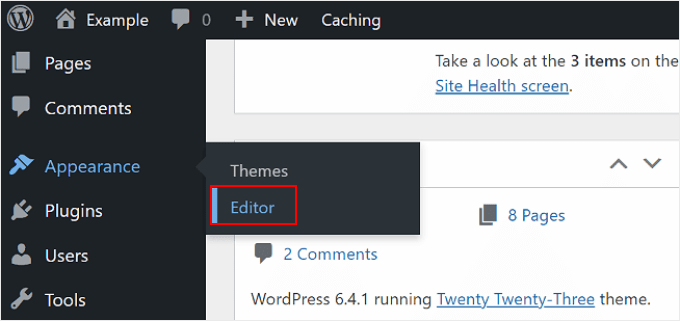
Auf dieser Seite finden Sie mehrere Menüs zur Anpassung Ihrer Website, darunter “Navigation” und “Stile”.
Für dieses Tutorial müssen Sie auf “Muster” klicken, um auf das Muster Ihres Website-Header-Blocks zuzugreifen.
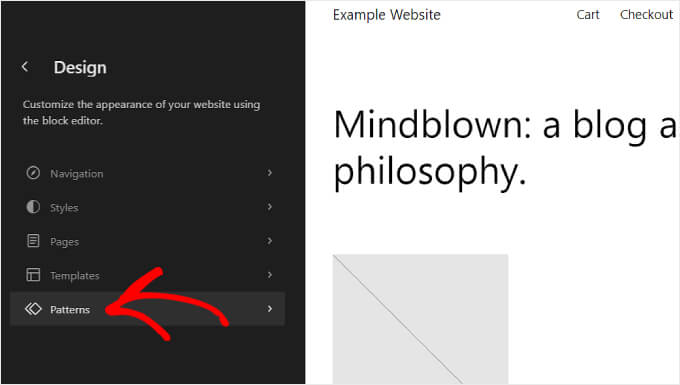
Wenn Sie nach unten scrollen, sehen Sie mehrere Vorlagenteile:“Kopfzeile“, “Fußzeile” und “Allgemein”.
Klicken Sie einfach auf die Vorlage “Kopfzeile”, um Ihr Favicon dort hinzuzufügen.
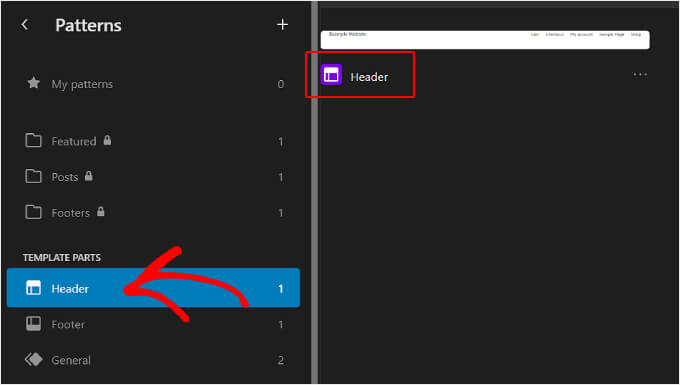
Als Nächstes sehen Sie eine Bleistift-Schaltfläche neben dem Kopfzeilentext.
Klicken Sie darauf, damit Sie das Muster bearbeiten und Ihr WordPress-Favicon einfügen können.
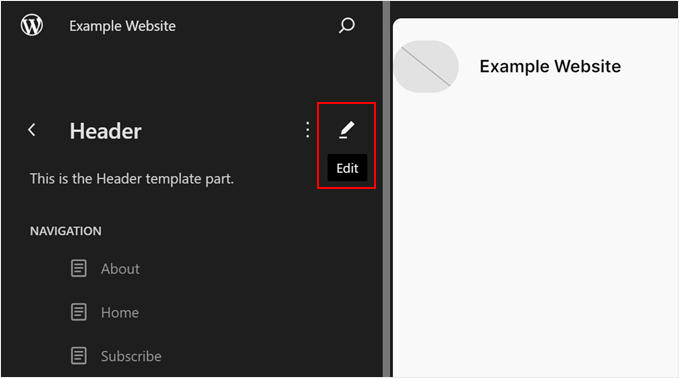
Sie befinden sich jetzt in der WordPress-Seitenbearbeitung.
Von hier aus können Sie auf die Schaltfläche “+” klicken und nach dem Block “Site Logo” suchen. Hier fügen Sie das Bild ein, das Ihr WordPress-Favicon werden soll.
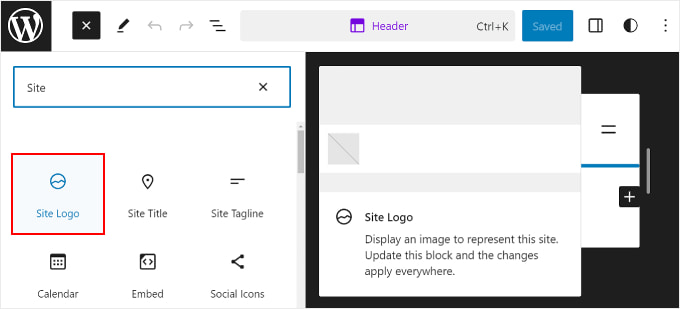
Ziehen Sie den Block einfach an die gewünschte Stelle in Ihrer Kopfzeile. In diesem Beispiel haben wir ihn neben dem Titel der Website platziert.
Als Nächstes klicken Sie auf das Upload-Symbol im Block “Site Logo”.
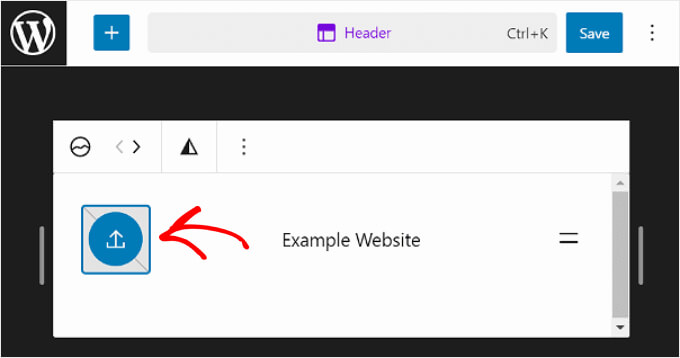
Wie bei der vorherigen Methode können Sie ein vorhandenes Bild auswählen oder ein neues Bild aus der WordPress-Mediathek hochladen.
Danach müssen Sie zur Seitenleiste der Blockeinstellungen auf der rechten Seite der Seite navigieren. Aktivieren Sie einfach die Einstellung “Als Website-Symbol verwenden”, um das Logo als Favicon hinzuzufügen.
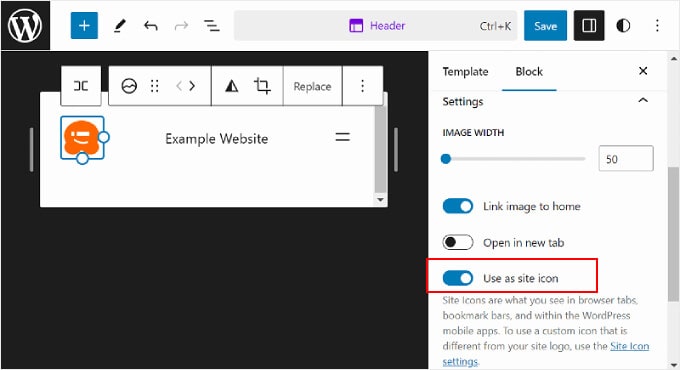
Schließlich können Sie auf die Schaltfläche “Speichern” in der oberen rechten Ecke der Seite klicken, um Ihr Favicon zu veröffentlichen.
Sie erhalten eine Warnung, dass sich die Änderung auf die gesamte Website auswirken wird. Vergewissern Sie sich, dass das Kästchen “Symbol” angekreuzt ist, und klicken Sie erneut auf “Speichern”.
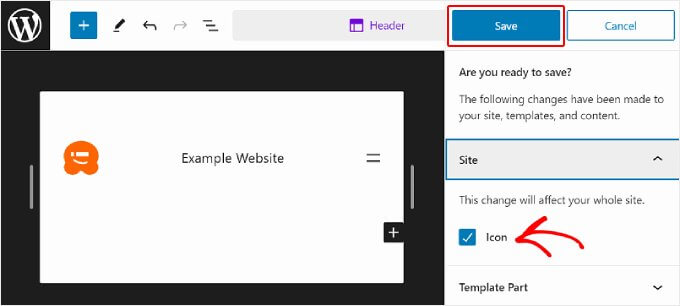
Nachdem Sie nun alle Schritte durchgeführt haben, können Sie Ihre Website öffnen, um zu bestätigen, dass die Änderung erfolgreich war.
Methode 3: Hinzufügen eines Favicons mit einem WordPress Favicon Plugin
Wenn Sie es vorziehen, ein WordPress Favicon-Plugin zu verwenden, dann können Sie diese Methode anwenden, um das kostenlose Favicon von RealFaviconGenerator Plugin zu verwenden.
Zunächst müssen Sie das Plugin installieren und aktivieren. Weitere Einzelheiten finden Sie in unserer Anleitung zur Installation eines WordPress-Plugins.
Nach der Aktivierung können Sie in Ihrem WordPress-Dashboard auf Darstellung ” Favicon gehen.
Danach klicken Sie einfach auf die Schaltfläche “Aus der Medienbibliothek auswählen”, um ein neues Bild hochzuladen oder ein bereits vorhandenes zu verwenden.
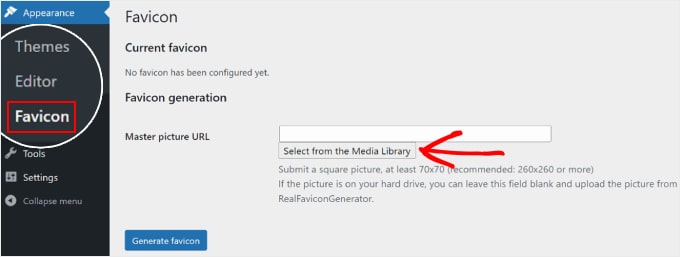
Beachten Sie, dass Sie ein quadratisches Bild verwenden müssen. Das Plugin empfiehlt, dass die Größe des Site-Icons mindestens 260 Pixel in Breite und Höhe beträgt, aber nicht kleiner als 70 Pixel ist.
Sobald Sie ein Bild ausgewählt haben, klicken Sie auf die Schaltfläche “Favicon generieren”.
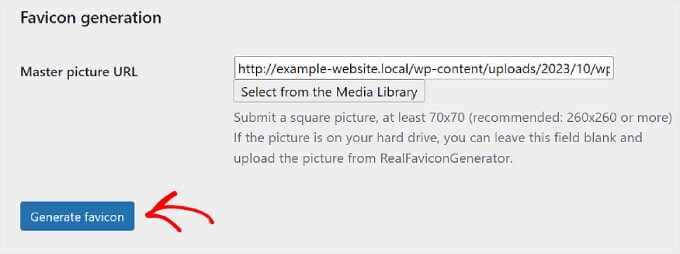
Danach leitet Sie das Plugin auf die RealFaviconGenerator-Website weiter, um das Favicon zu bearbeiten.
Sie können verschiedene Einstellungen vornehmen, z. B. die Hintergrundfarbe und die Darstellung auf Google-Suchergebnisseiten (SERPs), iOS, Android, macOS Safari, Chrome und Windows Metro.
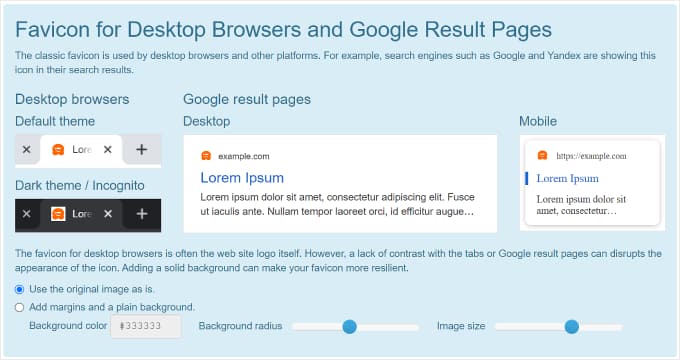
Im Abschnitt “Favicon-Generator-Optionen” können Sie das Kästchen ankreuzen, um zu sehen, ob Ihre Website bereits ein Favicon verwendet hat. Wenn ja, geben Sie einfach eine Zahl in das zweite Feld ein, um die Favicon-Version anzugeben, die Sie verwenden.
Auf diese Weise sehen Nutzer, die Ihre Website bereits besucht haben, das neue Favicon anstelle des alten.
Wenn alles gut aussieht, müssen Sie nur noch auf die Schaltfläche “Favicons und HTML-Code generieren” klicken, um das Favicon zu Ihrer WordPress-Website hinzuzufügen.
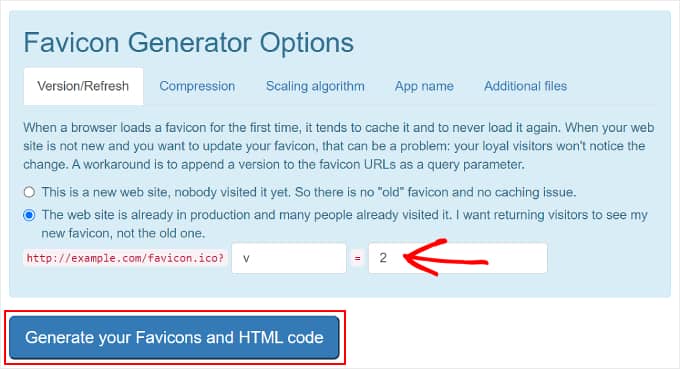
Ihr Favicon sollte jetzt aktiv sein. Achten Sie darauf, dass das WordPress Favicon-Plugin aktiv bleibt, damit das Favicon immer aktiviert ist.
Methode 4: Manuelles Hinzufügen eines Favicons zu Ihrem WordPress-Blog
Zu guter Letzt können Sie ein WordPress-Favicon zu Ihrem Blog hinzufügen, indem Sie die Codedateien Ihres Themes manuell bearbeiten.
Dies ist hilfreich, wenn Ihr Theme Customizer nicht über den Abschnitt ‘Site Identity’ verfügt oder Sie ein Block-Theme verwenden und ein anderes Favicon-Bild als Ihr Site-Logo wünschen.
Der einfachste und sicherste Weg, die Code-Dateien Ihres Themes zu bearbeiten, ist das WPCode-Plugin.
WPCode ist das beste Code-Snippets-Plugin für Anfänger. Mit über 1700 vorgefertigten Snippets und einer sicheren Fehlerbehandlung ermöglicht es Ihnen, benutzerdefinierten Code sicher einzufügen, ohne Ihre Website zu zerstören.

Ein weiterer Vorteil von WPCode ist, dass bei einer Aktualisierung Ihres Themes Ihre Codeänderungen, einschließlich Ihres Favicons, nicht verloren gehen.
Für diese Anleitung können Sie die kostenlose Version von WPCode verwenden. Mit dem Pro-Abonnement erhalten Sie jedoch Zugriff auf Funktionen wie intelligente bedingte Logik und Integrationen von Drittanbietern, um Ihren Code effizienter zu verwalten.
Um zu beginnen, müssen Sie WPCode installieren und aktivieren. Weitere Informationen finden Sie in unserer Schritt-für-Schritt-Anleitung für die Installation eines WordPress-Plugins.
Als Nächstes müssen Sie Ihre Favicon-Dateien vorbereiten. Hierfür können Sie einen kostenlosen Favicon-Generator wie Favicon.io verwenden.
Auf der Website können Sie auf “Bild” klicken, um eine Bilddatei in eine Zip-Datei und einen HTML-Code umzuwandeln. Alternativ können Sie auch die Option “Emoji” oder “Text” verwenden, um ein Favicon mit den verfügbaren Emojis und Schriftarten zu erstellen.
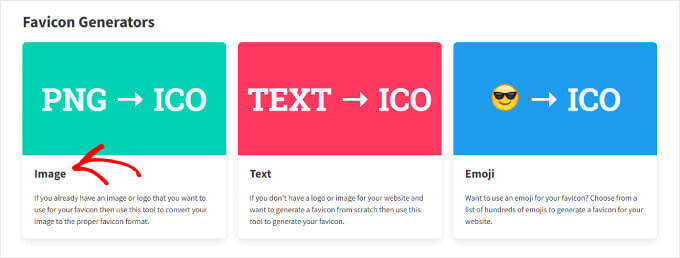
Auf der nächsten Seite können Sie Ihr Bild hochladen. Klicken Sie dann auf “Herunterladen”, um die Favicon-Zip-Datei zu speichern, die Ihre Dateien favicon.png und favicon.ico enthält.
Achten Sie darauf, dass diese Webseite während der nächsten Schritte geöffnet bleibt.
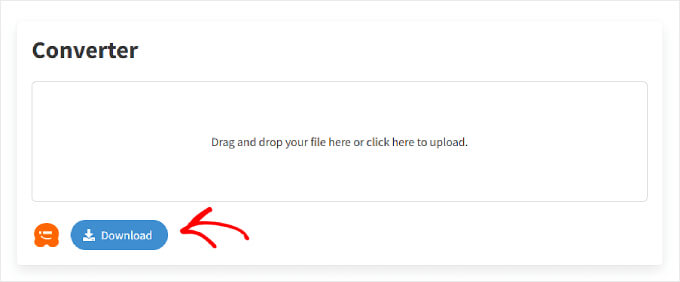
Nun müssen Sie die Favicon-Zip-Datei in das Stammverzeichnis Ihrer Website hochladen. Dazu können Sie den Dateimanager Ihres WordPress-Hostings verwenden.
Alternativ können Sie dies auch über einen FTP-Client wie FileZilla tun. Weitere Einzelheiten finden Sie in unserem Leitfaden für Einsteiger zum Hochladen von Dateien in WordPress mit FTP.
Sobald Sie die Dateien Ihrer Website über den Dateimanager oder FTP geöffnet haben, navigieren Sie zum Stammverzeichnis.
Das WordPress-Stammverzeichnis ist in der Regel ein Ordner namens “public” oder “public_html” und enthält wichtige WordPress-Ordner wie wp-content und wp-admin.
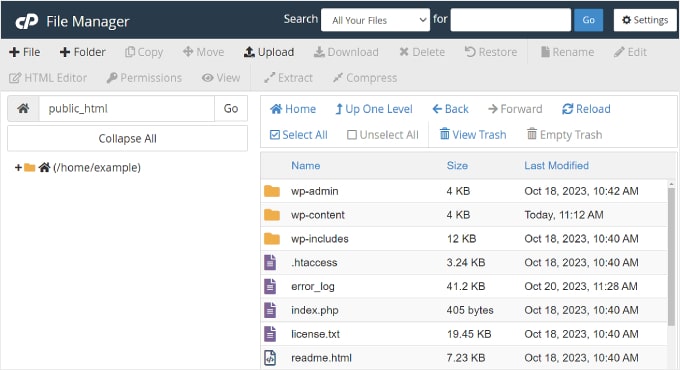
Jetzt können Sie alle Favicon-Dateien, die Sie zuvor heruntergeladen haben, extrahieren und in das Stammverzeichnis hochladen.
Wenn Sie den Dateimanager verwenden, können Sie auf die Schaltfläche “Hochladen” am oberen Rand klicken.

Dann erscheint eine neue Registerkarte, die Sie auffordert, die Dateien hochzuladen.
Auf dieser Seite können Sie auf die Schaltfläche “Datei auswählen” klicken und alle Favicon-Dateien auswählen.
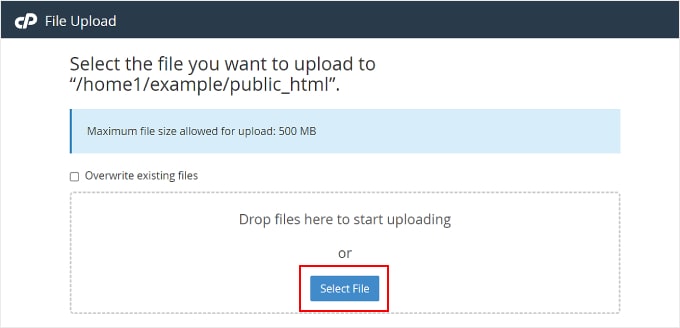
Warten Sie nun einfach, bis die Dateien erfolgreich hochgeladen wurden.
Danach können Sie zur Registerkarte “Dateimanager” zurückkehren. Sie sollten nun alle Ihre Favicon-Dateien im Stammverzeichnis sehen, wie auf dem Screenshot unten:
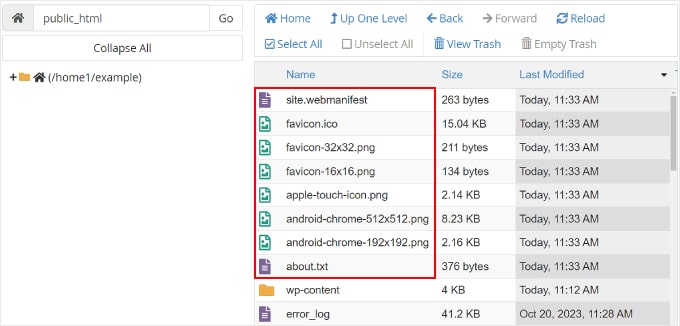
Kehren wir nun zum WordPress-Administrationsbereich zurück.
Navigieren Sie in der linken Seitenleiste zu Code Snippets ” Header & Footer.
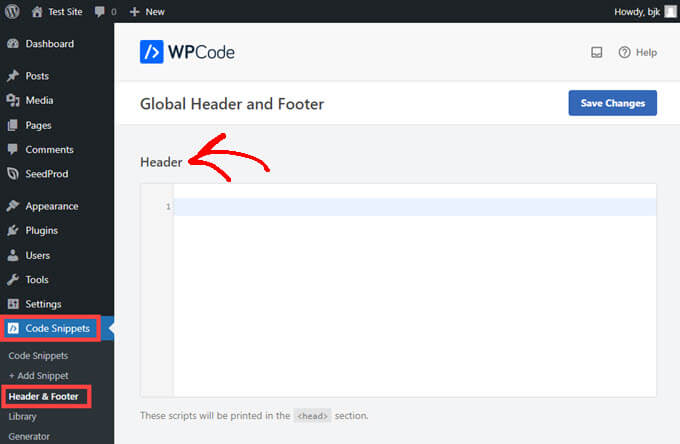
Danach kehren Sie zur Registerkarte Favicon.io von vorhin zurück.
Dann müssen Sie den HTML-Code von dort kopieren. Er sollte 4 Link-Rel-Tags im Code enthalten.
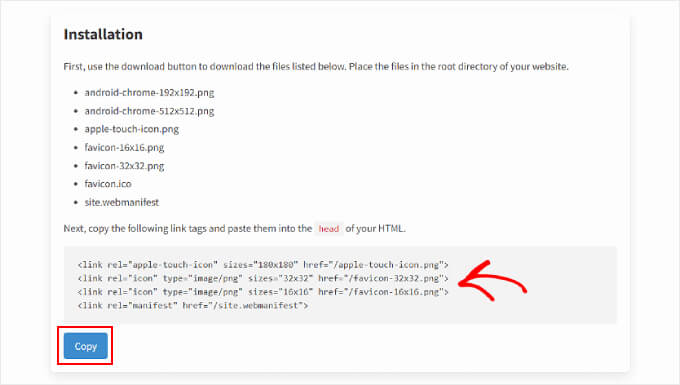
Als Nächstes müssen Sie zu WordPress zurückkehren und den Code in den Abschnitt “Header” auf der WPCode-Seite einfügen. Dadurch wird der Code in die Datei header.php Ihrer Website eingefügt.
Fügen Sie in den Code die vollständige URL Ihrer Website in Anführungszeichen neben allen href-Attributen ein, wie im folgenden Beispiel. Denken Sie daran, http:// oder https:// hinzuzufügen, wenn Ihre Website ein SSL-Zertifikat verwendet.
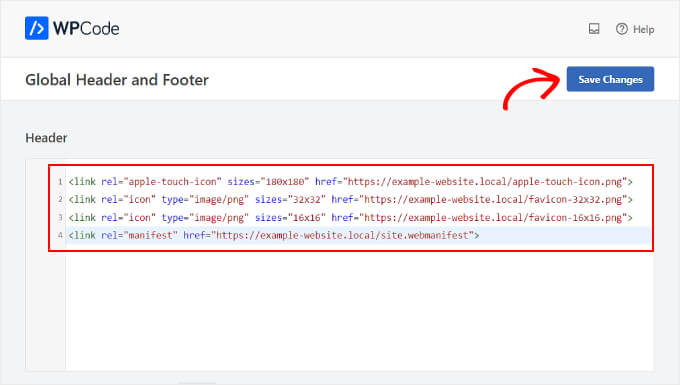
Abschließend können Sie auf die Schaltfläche “Änderungen speichern” in der oberen rechten Ecke klicken.
Und das war’s! Vergessen Sie nicht, Ihre Website zu besuchen, um zu sehen, ob die Änderung des Favicons erfolgreich war.
Warum wird mein WordPress Favicon nicht angezeigt?
Ein Grund, warum Ihr WordPress-Favicon möglicherweise nicht angezeigt wird, ist der Browser-Cache. Das bedeutet, dass Ihr Browser noch die alte Version Ihrer Website anzeigt.
Um dieses Problem zu lösen, müssen Sie den Cache Ihres Browsers löschen. Wenn Sie Hilfe benötigen, können Sie unsere Anleitung zum Löschen des Caches in Ihrem Browser befolgen.
Es ist auch möglich, dass Sie einen CDN-Dienst verwenden, der noch die alte Version Ihrer Website speichert. In diesem Fall müssen Sie den CDN-Cache leeren, um den Inhalt Ihrer Website zu aktualisieren.
Um zu überprüfen, ob Ihr WordPress-Site-Symbol hochgeladen wurde, können Sie Ihre Website im Inkognito-Modus oder in einem privaten Browserfenster öffnen.
Wenn die Installation des Favicons nicht erfolgreich war, können Sie versuchen, das Bild mit einem anderen Dateinamen erneut hochzuladen, um das Problem zu lösen.
Möglicherweise funktioniert die Icon-Funktion Ihrer WordPress-Website auch nicht, weil ein Fehler mit gemischten Inhalten vorliegt. Um dieses Problem zu lösen, lesen Sie unseren Leitfaden zur Behebung von WordPress-Fehlern bei gemischten Inhalten.
In manchen Fällen kann es auch vorkommen, dass auf Ihrer Website das Favicon Ihres Hosting-Anbieters statt Ihres eigenen angezeigt wird. In diesem Fall können Sie sich an das Support-Team des Anbieters wenden, um das Problem zu lösen.
Wir empfehlen, einen seriösen WordPress-Hostingdienst mit ausgezeichnetem Kundensupport zu wählen, um Probleme wie diese effektiv zu lösen. Sie können unsere Liste der besten WordPress-Hosting-Anbieter einsehen, um die beste Option für Ihre Website zu finden.
Schließlich sollten Sie prüfen, ob Ihr WordPress-Theme über ein spezielles Tool zum Hochladen eines Favicons verfügt. Dies kann erklären, warum die oben genannten Methoden bei Ihnen nicht funktionieren.
Wir hoffen, dass dieser Artikel Ihnen geholfen hat, ein Favicon zu Ihrer WordPress-Website hinzuzufügen. Vielleicht interessieren Sie sich auch für unsere Expertenauswahl der besten kostenlosen Logoersteller, die Ihnen helfen, wie ein Profi auszusehen, und für unsere Anleitung, wie Sie Ihrem WordPress-Theme ganz einfach Icon-Schriftarten hinzufügen können.
Wenn Ihnen dieser Artikel gefallen hat, dann abonnieren Sie bitte unseren YouTube-Kanal für WordPress-Videotutorials. Sie können uns auch auf Twitter und Facebook finden.





mohadese esmaeeli
In my opinion, having a favicon can attract the audience’s attention and add a stylish and aesthetic touch to the website in the browser. Perhaps it can capture the viewer’s gaze and be a distinctive feature.
mohadese esmaeeli
Hello. The favicon section of my website is not working. Even when I provide the url in the theme settings, it doesn’t show. I also tried from the site ID part, but it gives an error of not processing the image. Can you please guide me on this?
WPBeginner Support
If you are using the built-in option for your theme then we would first recommend reaching out to your theme’s support as they may have a specific requirement for the favicon image using their tool.
Admin
Jiří Vaněk
The last time I uploaded a favicon to a website, I struggled for a really long time with the icon not showing up on the website. I cleared the browser cache and wordpress itself and it didn’t help. She didn’t show up on her own until a few hours later. If someone is having trouble with it, the cache can be in many places. CDN, on the network element at home, on the server. So sometimes it’s good to just wait a while and not stress right away. Otherwise, the Favicon is a small thing, but it is a great way to customize your own page.
WPBeginner Support
Having a favicon can help with your SEO as well as to help users remember your site but it is not required and the first favicon you set can be changed to a different one later on.
Admin
Peter Iriogbe
Now I see why site owners stick to using Favicon which looks the same as their site logo.
Peter Iriogbe
Is it a must to upload a favicon or does it influence ranking on search?
Jiří Vaněk
Favicon is not necessary and does not affect SEO and search in any way. It is the personalization of the page. A favicon is great in two ways. If someone adds your page to their favorites, they will immediately recognize it by the favicon and do not have to search for a long time. The second great thing is when you have multiple pages open in your browser. You can also recognize the given page immediately by the favicon. So I definitely recommend having it, even if it doesn’t really affect SEO and search itself.
mohadese esmaeeli
Exactly, I agree. I’ve experienced the same issue. Often, when searching, I open various websites, and after an hour, I realize I have many tabs open in the Chrome browser, right in front of my eyes! However, having a favicon helps me quickly locate my desired site among the numerous tabs.
Javi
second alternative worked, thanks
WPBeginner Support
Glad to hear it worked
Admin
Meer Hamza
Is it manadatory to upload favicon at wordpress website in ICO file format.
WPBeginner Support
No, it does not need to be an ico format.
Admin
Meer Hamza
1-Is it ok to just upload site Icon from theme>customize>site Icon. Will it show as favicon?
2-I upload site Icon on wordpress website. Is it necessary to show Favicon at URL website.com/favicon
WPBeginner Support
1. Yes it is fine to upload it from there
2. It is not necessary but it can be helpful for finding the favicon later.
Admin
Alex Perry
Thanks, after 2 hours of searching I finally found it. How to change the site icon…
WPBeginner Support
Glad our guide allowed you to add it instead of needing to search further
Admin
Ben
I think this needs an update. I tried this and there’s no “Site Identity” tab under Appearance > Customize
WPBeginner Support
Your specific theme may have a custom editor or if you are using the block editor you could add the site logo block, set an image, and in the block’s settings have that set as the site’s favicon.
Admin
FAIZ
what a great guide, really it’s very helpful
WPBeginner Support
Happy to hear our guide was helpful
Admin
Max Anderson
What does the WPBeginner favicon represent?
WPBeginner Support
Our blob is a simple design of a face smiling using an exclamation point and parenthesis
Admin
AL
Hi, what to do when Favicon is not showing on chromium-based browser and shows up in Firefox.
WPBeginner Support
You would normally want to clear your site’s cache as well as try setting the favicon again for a common reason.
Admin
John
I’m new to this so would appreciate some guidance with favicon. The website I’m trying to look after needs the favicon changing. Can I load a new image as a favicon that will overwrite the favicon currently on the pages or must i delete the current one then load a new image?
Thanks for any reply
WPBeginner Support
You would want to reach out to the support for your specific theme for if your theme has this option.
Admin
Ray
I was fine on the video until you said “click on site identity”… there is no such tab on my version. The first option is “Global” then Header, Breadcrumb, UberMenu{main], Blog, etc. No “Site Identity”…so obviously without being to get to that screen I’m not going anywhere. Is there another way in?
WPBeginner Support
If your theme has different settings and you are unable to find the favicon in the customization settings, you would want to reach out to the support for your specific theme to see if they have it located in a theme-specific area.
Admin
Krishna
Hii Wpbeginner!
I’m using Astra theme my website Favicon is working every one except Google search results. How can I fixed it?
WPBeginner Support
You would need to wait for Google at the moment.
Admin
Soul sultan
This is the awesome guide about how to add favicon on wodpress blog
WPBeginner Support
Thank you, glad you found our content helpful
Admin
Shomirul Islam Bonny
Thanks! It helped me!
WPBeginner Support
You’re welcome, glad it helped
Admin
Munendra Singh
all helpful post,, thanks
WPBeginner Support
Glad you found our post helpful
Admin
Raj
Great ! I always go through from your tutorials when ever i get stuck in any kind of issue. Thanks for it.
WPBeginner Support
Thanks, glad our articles could help
Admin
John Barson
Can’t Add a Favicon to Your WordPress Website? That was my problem. I did a fair bit of research where I finally found my issue. It was because the PHP GD Library was not enabled. Fortunately, I control my own server. I had upgraded the server PHP to v7.2 but I forgot to enable the PHP GD library. So…if you find when you try to add the site icon in the appearances section of your wordpress admin and the image you upload/select is not being accepted or you can’t use the crop image feature it is most likely because your webserver host has not enabled the GD Library.
WPBeginner Support
Thanks for sharing this information should someone else run into that issue
Admin
Cean Herzfield
Thank you so much! You saved me a lot of frustration because I’m working on Xampp and it was disabled by default. Now wouldn’t it have been nice if they had mentioned it in the article.
Pritam
Favicon of my website was visible before I changed DNS for Cloudflare. Now it is visible in the admin side but not on the website. How to solve this problem. you can check on my website
Michele A
This tutorial was wonderful! Thank you so much for the great work!
Jacques
My Favicon is updating in ADMIN side, but not on user side
Tracy
Were you able to figure out how to fix it?
RAJ
“When I go to the “Site Identity” tab, there is no place to upload a site icon. The only option I have is the “Site Title”. That’s ALL!
I am using WordPress 4.7.3.”
Bekzat Sadykov
I guess, the WP theme you are using doesn’t have favicon implemented. So, if it is not declared in theme functions.php file, it won’t appear in admin/editor side.
You can hardcode it to header.php or use third-part plugins.
jacob
scroll down a little you will see the place to upload your favicon
Eleanor
Hi, I recently updated my website from HTTP to HTTPS and when that happened, the site icon stopped working. Does this mean that somewhere along the line I’ve missed a step? I’ve tried changing the image and reuploading a new one and that hasn’t worked. If someone types in the website URL using http then the old favicon (and not site icon) shows up, but the minute it’s https, then it disappears. The site icon though is visible when I’m logged into the dashboard.
Matt Parker
Eleanor
I’m on HTTPS and I have the same issue, did you find a solution?
Favicon only shows when I’m logged in in admin mode!
Jimmy
When I go to the “Site Identity” tab, there is no place to upload a site icon. The only option I have is the “Site Title”. That’s ALL!
I am using WordPress 4.7.3.
Please help!
Ahmed Akeem
I guess, the WP theme you are using doesn’t have favicon implemented. So, if it is not declared in theme functions.php file, it won’t appear in admin/editor side.
You can hardcode it to header.php or use third-part plugins.
Abubakar Sahabi Rafi
It really helped, more grease to our elbow.
Tim
Can anyone tell me how this new “Site Icon” feature is supposed to work? I get to the point where the file is uploaded and I get a dialog box that offers to crop the image. The problem is 1) my image doesn’t need to be cropped and 2) there’s no “Save” button (or “Done” or anything similar), only a “Crop” button and the upper right corner X to close the dialog. If I click “Crop” I get an error (Error cropping this image, bla bla bla) and if I hit the X it closes. Either way, my image is not saved as a Site Icon (even though it is saved in the media library. After deleting the image, resizing it to exactly 512×512, I upload it again. This time, no crop dialog, just the “Select” image dialog. I click select, the image has a box around it and a check mark and nothing else happens. No Save, etc. When I close the dialog, there’s still “No image selected.” This happens in Chrome AND Firefox. I’m ready to throw WordPress away and hand code everything. I haven’t used WordPress in a couple of years and I’m frustrated with what seems like buggy, poor design and feature bloat.
Brian
code easy to interpret, it worked out. thanks…
Jason
Why does it need to be 512 pixels for an icon? I’m hoping it’s converted somewhere inside WordPress, once and done, and not on every load. 512×512 is crazy for something that would very rarely be bigger than 32X32, unless I am missing something?
John Krawczyk
Article not useful. Everyone tells you to make a path to your favicon & that’s it.
However do you include http: www http do you specify .ico .png?
Nobody says anything in detail.
WPBeginner Support
Hi John,
Yes you need to include full URL like this:
https://www.wpbeginner.com/favicon.pngAdmin
Joe
Using WP4.7 and the Site Icon functionality works, but it just seems off to me. The result is 4 links in the section:
But it creates 10 different versions of the site icon image in addition to the original at sizes of 32×32, 100×100, 150×150, 180×180, 192×192, 250×250, 270×270, 300×300, 360×360, 500×310.
Why so many cropped images if only 4 linked to?
Also, I submit an icon image sized 512×512 as recommended, but the 500×310 version is always cropped so the top and bottom of the icon is cut off. Is there any way around this and/or is it a big deal?
What browser support does this WP Site Icon cover (mostly in respect to how far back in IE)?
Thanks!
Marieke
In Whatsapp, the image which appears left to a link address if you send a link: is that the same icon? Because I don’t see it there.
Sunil
Marieke, It’s featured image, you upload to a particular post.
Cos
The ICO Format plugin for Adobe Photoshop does not allow images more than 256 pixels high or wide. So how do you create one that’s 512px???
Marieke
It doesn’t need to be made an .ico. Just a plain .png or .lpg will do when you work in WordPress.
Salim Ahmed
Informative instruction. Now i following your tips and tricks. Thanks for sharing it.
Taimoor Ahmed
Kindly tell me any website or a software from where I can make an effective favicon for my site in a quick time????
Kirstie
Thank you for another simple to follow tutorial. I’m a true beginner and y’all do a great job explaining things in a way I can understand.
WPBeginner Support
Thanks, glad you find our tutorials helpful.
Admin
Nelson
thanks good tut easy and works
c
the add logo in some themes isn’t for favicon its for the header logo
ccstacyline
how come my side identity menu doesn’t have the service for site icon? I am so frustrated… can you help ?
John Davis Frain
Are the instructions you give here theme-specific? I’m using the Delicacy theme, and it doesn’t give me that option to alter Site Identity and insert a Favicon.
WPBeginner Support
No it is not theme specific. Make sure you are using the latest version of your theme.
Admin
Mad Dog Malcs
Hi There, I also don’t see the site identity tab, I am using the sketch theme, how do I update a theme?
Thanks in advance, Malcs
shashi
i may go to theme custimztion..there u see the option of uploading the favicon icon easliy…
Antonios
You might not see the word “favicon” probably site icon. If you see a scrow bar you might have to scrow all the way down to see the select image box.
a
You can add favicon by WordPress’ “Costumize” editor, which can be found in every wordpress site.
Alan
I upload a PNG file that is exactly 512×512 pixels, WordPress saves it, and then I end up with a cropped image in my media library. Super annoying! WordPress 4.4.
Alan
I should add that the new, cropped image is exactly the same dimensions as the original I uploaded, but now I have two in my library (albeit one has been processed twice, and has actually increased two kilobytes in file size!).
Katherine Johnston
I have gone through the directory, exactly as you described, but my Site Identity tab only has “Site Title”, “Tagline”, and a checkbox for displaying header text. How can I fix that? Or do I have to go the FTP route?
Thanks for the help!
Rahul Thakur
thank you so much, very simple way love it.
Liz
Excellent instructions, took me about 32 seconds to do it. Fabulous! Thank you
Erin
Thanks! This was very helpful.
Marie Bock
Wow! That was so easy with the newer version of WordPress.
Matt
Super-easy! Thanks for that – I just need to go away and design a better logo now
Viscoun
Doesn’t work. When I got to Customize > Site Identity, the site icon option doesn’t show up – it only says “Site Title” and “Tagline”.
david
what version of wordpress are you using?
Harshpreet
Hi same is the problem I am facing and I am using the website of wordpress on my laptop for building up my blog!
Gina
I’m having the same problem. I’m using wordpress directly online, I haven’t downloaded anything. No “site icon” option at all.
WPBeginner Support
Please see our guide on the difference between self hosted WordPress.org vs free WordPress.com blog.
Admin
Lourika
It took me forever to figure it out!!!!
In the top left corner, click on MY SITES
Go to WP Admin
Then click on SETTINGS
and you will be able to change the icon (picture) on the right hand side……